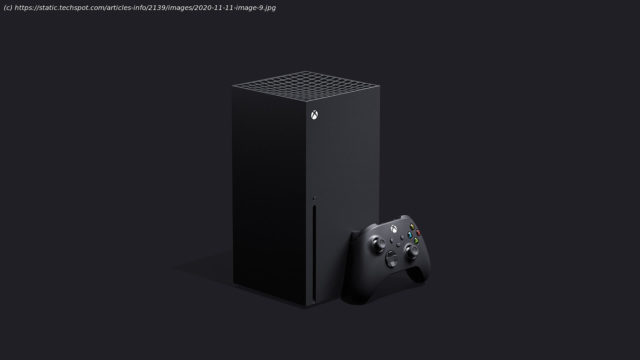The Xbox Series X is the most boxlike Xbox that Microsoft has ever produced. It’s a cuboid: 12 inches tall, six inches deep, and six inches wide,…
The Xbox Series X does not feel like the kind of machine we usually get at the start of a new generation, when we’re used to clean breaks with radical new hardware that basically starts our time with a PlayStation, Xbox, or Nintendo device over. Instead, the Series X feels like another version of Microsoft’s last console, the Xbox One. It feels like a much more powerful Xbox One with a striking new look, blazing-fast loading times, and an extra button on its controller. For many reasons, it’s the very best Xbox One. The Xbox Series X is the most boxlike Xbox that Microsoft has ever produced. It’s a cuboid: 12 inches tall, six inches deep, and six inches wide, all right angles and fine matte black plastic. I adore its simplicity. It’s a box with a modest, circular X-logo button in the top left or top right corner, depending on whether you place it horizontally or vertically. Pressing that button causes the system to emit the same three-note beep as pressing the circular X-logo button on the Xbox One. From there the system launches into its home screen, seen below. Hold up, that’s not the right screenshot. That’s a screen from my Xbox One X. Here’s my Xbox Series X home screen… Every game on my Xbox One runs on my Xbox Series X. That includes nearly every backward compatible game for the Xbox 360 and original Xbox. The only games that will not work are those that require Kinect, Microsoft’s failed spy camera accessory. How does the Xbox Series X achieve such awesome backward compatibility? Simple. It’s an Xbox One with more powerful guts. In 2017 I said that the Xbox One X, Microsoft’s incremental upgrade to the Xbox One, is “a box filled with powerful components that’s designed to do the same thing as a box with less powerful components, only a little bit better.” Replace “a little bit” with “a lot” and you’ve got the Xbox Series X. It does 4K resolution more readily than the Xbox One X. It reaches 60 frames-per-second more readily at higher resolutions. That additional graphics power means the Xbox Series X can reach up to 120 frames-per-second at lower resolutions, liquid-smooth frame rates once purely the domain of gaming PCs. It can even output graphics at 8K, which to many entertainment consumers is still some sort of mythical beast. (Note: Alongside the X, Microsoft is launching a second, cheaper new console called the Xbox Series S. More on that one at the end of this review.) By using a faster processor, doubling the graphics power, installing more, speedier memory, and including a solid-state storage drive set to ludicrous speed, Microsoft has created the ultimate Xbox One. It makes sense. Those are the components I would upgrade in my PC if I wanted the games I have there to perform better. My current desktop setup. The issue of the Xbox Series X’s heat output came up during an early preview program held by Microsoft last month. Now that I’ve had my hands on the system I’m pleased to report that while it is quite warm, my hands have not burnt off of my wrists. There’s a strong heat coming from the system’s vents, but nothing I’d consider worrisome. With my current setup, it functions as a convenient finger warmer, which is nice as the winter rolls in. What’s important is the fan is very quiet, the vapor chamber cooling does its job, and the console has yet to explode. Harnessing all of this extra power, Microsoft has implemented a number of improvements and features that wouldn’t be possible on older Xbox One consoles. The fabled “Quick Resume” feature, which allows players to hop between games quickly by creating save states that persist even if the system is completely removed from power is a game-changer, literally and figuratively. The ease at which you can switch between games that utilize the feature is unprecedented in a game console. I can be in the middle of playing Ori and the Will of the Wisps, hit the home button on the Xbox Series X controller, start up Dirt 5, realize I don’t like Dirt 5 and quickly switch back to Ori, picking up exactly where I left off. I’ve been juggling Lego Worlds, Forza Horizon 4, Yakuza: Like A Dragon, Bright Memory, and Ori and the Will of the Wisps. That’s pretty cool. Even cooler are the incredible loading times made possible by the Xbox Series X’s “Velocity Architecture.” More than just a speedy custom SSD drive, the Velocity Architecture is a combination of hardware and software innovation that changes the way the Xbox Series X accesses and decompresses information. Basically, the system’s data output is fast, its channels wide, and delivery methods customizable enough that developers can make games load very quickly. The back side of the Series X, complete with fancy SSD expansion port for upgrading storage. The Xbox Series X/S enhanced version of Forza Horizon 4 is the perfect example of the benefit of the Velocity Architecture. On the Xbox One X, where I’ve put dozens of hours into exploring the game’s vast open world, it takes 83 seconds to go from hitting start after the menu screens to gameplay.






